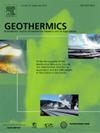华南冕华坑铀矿床地热水文地球化学条件及成因
IF 3.9
2区 工程技术
Q3 ENERGY & FUELS
引用次数: 0
摘要
绵华坑地热系统处于含铀花岗岩环境中,地表热流高(62.7 ~ 90.4 mW/m2),地热潜力巨大。本研究结合地球化学和同位素分析,阐明了该系统的起源、演化和控制机制。同位素证据表明,大气水是主要补给源,渗透深度为1617-4030 m,导致地热储层温度估计在56°C至111°C之间。地球化学研究表明,深层地热水与水岩相互作用的混合作用,如硅酸盐风化(如钠长石、黑云母)、硫酸盐溶解(石膏)和阳离子交换,导致了Na+、Ca2+、SO42−和HCO3−的富集。此外,萤石与黑云母的共溶作用以及深层流体的混合作用可能是造成地热水中F−含量高的原因。含铀花岗岩的放射性产热是研究区地热系统热态的主要热源,平均产热率为5.14 μW/m3。提出了一个基于水文地球化学的概念模型,为花岗岩类环境地热系统的特征提供了一些新的认识。本文章由计算机程序翻译,如有差异,请以英文原文为准。
Geothermal hydrogeochemical conditions and genesis of the Mianhuakeng uranium deposit, South China
The Mianhuakeng geothermal system, hosted in a uranium-bearing granitoid environment, exhibits a high surface heat flow (62.7–90.4 mW/m2), indicating significant geothermal potential. This study integrated geochemical and isotopic analyses to elucidate the origin, evolution, and controlling mechanisms of the system. Isotopic evidence indicates that meteoric water is the primary recharge source, infiltrating to depths of 1617–4030 m, resulting in estimated geothermal reservoir temperatures ranging from 56 °C to 111 °C. Geochemical studies suggest that the mixing of deep geothermal water and water-rock interactions, such as silicate weathering (e.g., albite, biotite), sulfate dissolution (gypsum), and cation exchange, lead to the enrichment of Na+, Ca2+, SO42−, and HCO3−. Moreover, the co-dissolution of fluorite and biotite as well as the mixing of deep fluid may be the cause of the high F− level in geothermal water. The radioactive heat production of uranium-bearing granite is a major heat source in the study area that provides to the thermal regime of geothermal systems, with an average heat production rate of 5.14 μW/m3. A conceptual model based on hydrogeochemistry was proposed, providing a few new insights into the characteristics of geothermal systems in granitoid environments.
求助全文
通过发布文献求助,成功后即可免费获取论文全文。
去求助
来源期刊

Geothermics
工程技术-地球科学综合
CiteScore
7.70
自引率
15.40%
发文量
237
审稿时长
4.5 months
期刊介绍:
Geothermics is an international journal devoted to the research and development of geothermal energy. The International Board of Editors of Geothermics, which comprises specialists in the various aspects of geothermal resources, exploration and development, guarantees the balanced, comprehensive view of scientific and technological developments in this promising energy field.
It promulgates the state of the art and science of geothermal energy, its exploration and exploitation through a regular exchange of information from all parts of the world. The journal publishes articles dealing with the theory, exploration techniques and all aspects of the utilization of geothermal resources. Geothermics serves as the scientific house, or exchange medium, through which the growing community of geothermal specialists can provide and receive information.
 求助内容:
求助内容: 应助结果提醒方式:
应助结果提醒方式:


